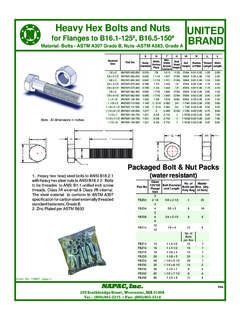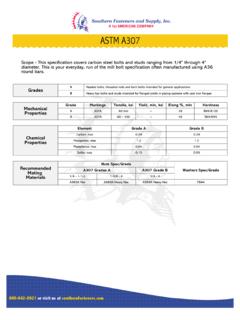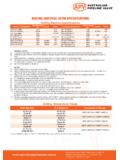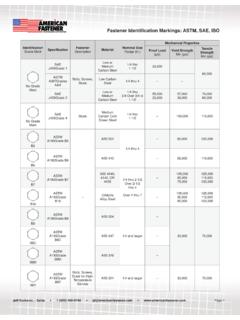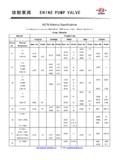Transcription of Technical Bulletin - The Boulder Company
1 Technical Bulletin INDUSTRIAL FASTENERS INSTITUTE Website: Proper Matching 0f Bolt and Nut Strengths Is Critical It is obvious that if a bolted joint is subjected to enough force, sooner or later, something must fail. From a design point of view, some types of failures are more desirable than others. One widely accepted principle of joint design is as follows: The desired mode of failure of a bolted joint is the complete fracturing of the bolt or screw instead of the stripping of the thread in the nut or in the internally threaded component. The reasoning behind this principle is simple.
2 When a bolt or screw breaks during initial assembly, the joint failure is obvious. When this happens, the broken bolt or screw can be replaced before more serious damage occurs in the assembly. When an internal thread strips during assembly, the joint failure is frequently not obvious by visual inspection. This can create very dangerous situations in which the assembly may completely come apart and fail when the assembly begins its function and is subjected to its operating loads. These types of failures can result in huge financial losses and can possibly put lives in danger.
3 The following rule should be followed when nuts are selected for use with bolts or screws: Whenever possible, a nut should have a proof load capacity equal to or greater than the minimum ultimate tensile strength of the bolt or screw with which it will be used. The proof load capacity of nuts and the ultimate tensile strength of screws and bolts can be found in the various fastener standards including those published by the American Society of Testing and Metals ( astm ), the Society of Automotive Engineers (SAE), and the International Standards Organization (ISO).
4 The specific standards used as references for this article are as follows: E-mail: Page 1 of 2 Technical Bulletin INDUSTRIAL FASTENERS INSTITUTE Website: E-mail: Page 2 of 2 SAE J449 SAE J995 ISO 898-1 ISO 898-2 astm A193 astm A194 astm a307 astm A325 astm A354 astm A449 astm A490 A great general reference containing data from all of these sources and more is Every Thing An Engineer Should Know About Threaded Fasteners, written by Alexander Blake.
5 This book is published by Marcel Dekker, Inc. and is available from the Industrial Fastener Institute (IFI) at 216-241-1482. Below are charts taken from the above mentioned standards for inch and metric coarse thread bolt and nut sizes covering 1/4 inch through 1 inch and M5 through M24. These charts show the minimum ultimate strength values for the bolts and the proof load capacity values for the nuts. When determining what nut grade to use with a given bolt: 1. Find the bolt s ultimate tensile strength by thread size and strength grade in the appropriate chart.
6 2. Locate the thread size line in the appropriate nut chart that matches the bolt s thread size and select the nut grade to use where the nut s proof load capacity value is equal to or greater than the bolt s ultimate tensile strength. Examples of correct nut selections for given bolts: Thread size Bolt Grade Or Property Class Bolt s Ultimate Tensile Strength Nut Grade Or Property Class Nut Proof Load Capacity 3/4-10 SAE Grade 5 40,100 lbs. SAE Grade 2 Or astm A563 Grade B 40,100 lbs. Property Class 163,000 N Property Class 10 164,900 N Fastener users should always make the final choice of which nut to use with which bolt, but if asked, suppliers should share these principles with them.
7 Fastener users should be warned that using a lower grade nut to save on the initial purchase price of fasteners could prove to be false economy. If the nut s threads strip during installation and the failure goes undetected, the entire assembly may fail when it is put into use. When this type of catastrophic failure occurs the supplier usually has to defend himself against accusations about having supplied fasteners of poor quality. This is unfair and unjust when the root cause of the failure is poor nut selection by the user.


